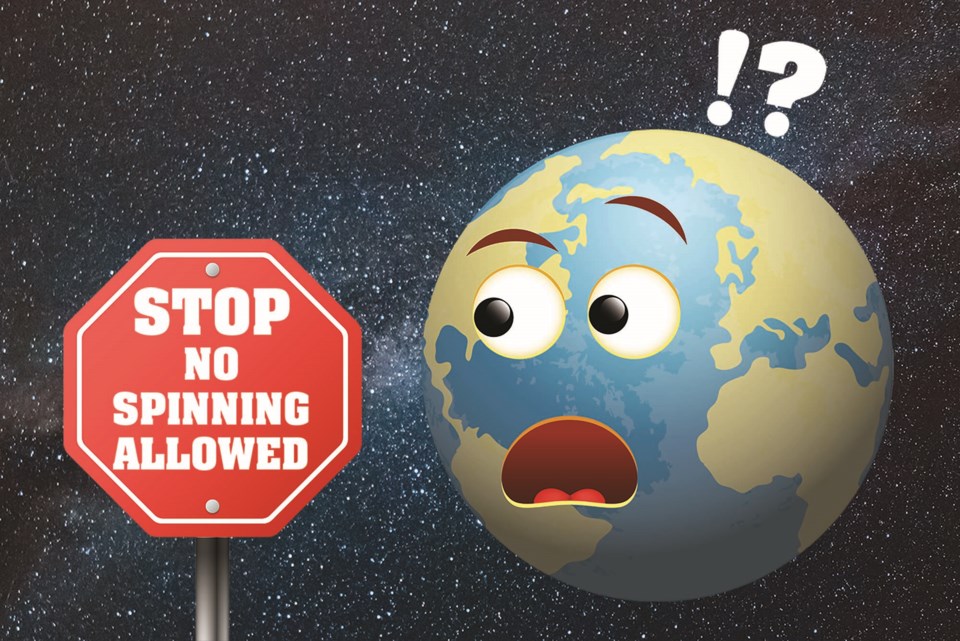Scientific St. Albert
The Gazette is using science to answer questions from students of all ages about the world around them. Send in your questions to [email protected].
Sometimes you just want to stop the world for a bit.
Rodney, a Grade 2 student at Wild Rose Elementary, may have wanted to do so when he asked Scientific St. Albert, “What would happen if the Earth stopped spinning?”
How to stop spinning
To stop the Earth from spinning, we’ll need to counteract the 2 x 10^29 joules of rotational kinetic energy it possesses, Chris Mann, exoplanet scientist at the University of Montreal, said in an email.
“Now that number doesn’t mean much to anybody, but that is about one million times more energy than the asteroid that wiped out the dinosaurs imparted onto the Earth,” he noted.
Mann said chucking the moon or Mars at Earth might do the trick, but that wouldn’t leave us with much of a planet. Alternatively, we could apply a smaller force over a much longer time period, as the moon is doing to Earth now.
“Because our moon raises the tides on Earth — most obviously in the oceans, but a bit even in the rock — it is actually slowing the Earth’s rotation via gravity,” Mann said.
Researchers have determined that this effect has already added about 1.7 milliseconds to the Earth’s day in the last 100 years, said University of Alberta physicist Roger Moore in an email and phone interview. This won’t completely stop the Earth’s spin, but after a few billion years, it will make Earth’s spin equal to its orbital period, meaning one day will last one year. This has already happened to the moon, which is why we always see the same side of it.
You could stop the Earth faster if you took an absurd number of really strong rockets aimed eastward and put them on the end of a really strong tower, Mann said.
“You’d need an insanely tall tower,” he noted, as the rockets would have to be outside Earth’s atmosphere, lest the resulting wind counter their thrust.
Mann said we could also mount a huge, indestructible frictionless gyroscope at the north or south pole and spin it opposite to the Earth’s rotation, which would effectively store the Earth’s angular momentum in the gyroscope. If the gyroscope stored all that momentum, the Earth would stop spinning.
What happens next
What happens next depends on how fast we stop the Earth and how we define “stop” and “Earth.”
“The Earth isn’t a solid object,” Moore noted, and has a liquid outer core and oceans and air sloshing about its surface.
Even if you assume everything from the crust down stops, if you do it suddenly, everything on the surface will still be travelling very, very fast eastward, noted St. Albert amateur astronomer Murray Paulson in a phone and email interview. Around Edmonton, your speed would be about 1,000 km/h.
“It would be really exciting for a few seconds travelling at supersonic speed until you hit something or something hit you, but then you would splatter like a water balloon,” Paulson said.
Paulson said you might survive if you were standing at the North or South Pole when the stop happened, as you wouldn’t have any speed there. Everywhere else would experience supersonic winds and tsunamis that would scour the surface clean.
“It would be a really bad day.”
Once you’ve stopped the Earth, one of two things would happen, depending on how we define “stop.”
Astronomers define days based on the position of stars, Mann said. A solar day happens when the sun returns to the same point in the sky, while a sidereal day happens when the stars return to the same spot.
If we stop the Earth so that the sun stands still, one side would bake in the eternal day while the other would freeze in eternal night, Mann said. Some “tidally locked” planets are already like this.
If we make the stars stand still, an Earth day would become the same as an Earth year, with every location getting six months of light followed by six months of dark, Paulson said.
“We would have a desert planet,” he said, frozen for half the year and roasted for the other half.
A non-spinning Earth would disrupt the lives of plants, bees, and anything used to a day-night cycle, noted Astronomy.com writer Nathaniel Scharping. We wouldn’t get hurricanes, as they need the Earth’s spin to get really powerful, but we would get really long sunsets. If the Earth’s liquid metal core also stops spinning, the planet would likely lose its magnetic field, which would let more cosmic radiation bake the surface.
In any case, the moon would eventually spoil our spin-free future.
“The moon tugging on the Earth would probably start it rotating again after a time,” Paulson said, and eventually the same side of Earth would be facing the moon all the time.
“The moon would become fixed in the sky,” Moore noted, but half the planet would never see it.
If you really want to make the Earth stand still, you’ll probably have to blow up the moon at some point.



